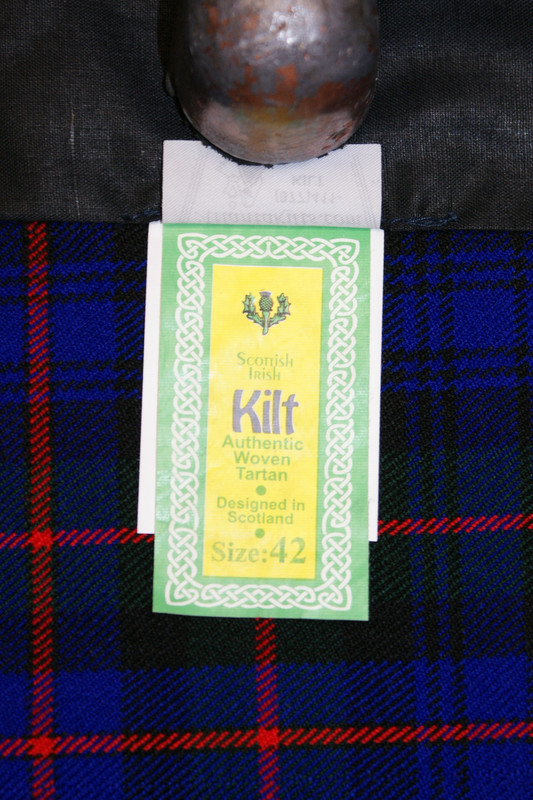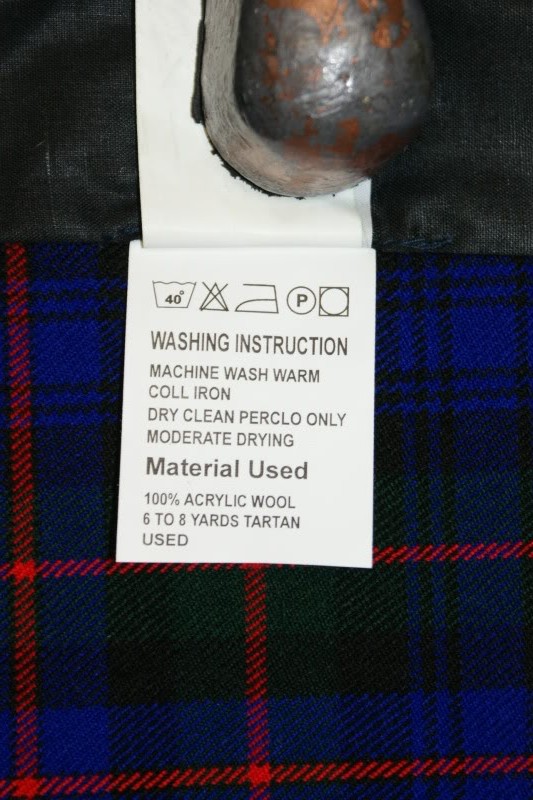|
-
Fabric from scotlandkilt
Hello,
Has anyone had any experience with fabric from. https://scotlandkilt.com/tartan.html
I am wondering how it would be for a daily wear box pleated kilt.
Thanks
P.S. I have been in touch with them. They said that the fabric is a wool and acrylic blend. I was wondering if anyone has any actual dealings with them.
Last edited by ddevine77; 10th May 22 at 01:59 AM.
Reason: More information
-
-
No idea about the company, but a fabric that cheap should raise questions. They don't even say what the fabric is made of. If it is wool, I wouldn't be surprised if it was made cheaply in Pakistan. I could of be wrong but buyer beware.
Tha mi uabhasach sgith gach latha.
“A man should look as if he has bought his clothes (kilt) with intelligence, put them (it) on with care, and then forgotten all about them (it).” Paraphrased from Hardy Amies
Proud member of the Clans Urquhart and MacKenzie.
-
-
If you scroll down to the bottom of the screen in the link you provided, and click on the "Contact us," it gives you their address as:
Abadi Mehar Hakam Din Rum, Saidpur Road
Tehsil & District Sialkot 51310
Punjab, Pakistan
00 92 342 1641485
Could be that they've outsourced their call center as so many companies have, but I'd be willing to bet it's a Pakastani company.
I'm with kilted2000 on this one...
Let us know how it turns out if you decide to take the plunge!
Cheers,
SM
Shaun Maxwell
Vice President & Texas Commissioner
Clan Maxwell Society
-
-
Quote from their website:
“ This is Acrylic wool tartan. ”
From “sewing is cool.com”:
“ What is Acrylic Wool?
There is a little controversy surrounding this topic. Wool is extremely hard to blend with other fabrics including acrylic. That means that there really is not acrylic wool blend on the market today, at the time of this writing.
It would be nice if the two fibers could be blended as then you would get the best of both worlds. The controversy comes in as there are companies that advertise and claim they sell a wool acrylic blend. When investigated, those claims are found to be false.”
waulk softly and carry a big schtick
-
The Following User Says 'Aye' to jhockin For This Useful Post:
-
 Originally Posted by jhockin

Quote from their website:
“ This is Acrylic wool tartan. ”
From “sewing is cool.com”:
“ What is Acrylic Wool?
There is a little controversy surrounding this topic. Wool is extremely hard to blend with other fabrics including acrylic. That means that there really is not acrylic wool blend on the market today, at the time of this writing.
It would be nice if the two fibers could be blended as then you would get the best of both worlds. The controversy comes in as there are companies that advertise and claim they sell a wool acrylic blend. When investigated, those claims are found to be false.”
So what are they actually if they aren't what's claimed? I think I saw a BC company that says it sells 75% wool 25% acrylic kilts.
-
-
I would say “ buyer beware” 😞
waulk softly and carry a big schtick
-
-
Acrylic fibers are synthesized from either petroleum or coal based chemicals.
Acrylic has the potential to be the most wool like of all the synthetic fibers. - It is lightweight, soft and warm.
Acrylic fibers were first introduced in 1941 by Dupont under the brand name "Orlon".
Acrylic has a low melting point and a low flash point. This has been demonstrated quite a few times by holding a match to an Acrylic fabric kilt and have it end up as a molten puddle of charred plastic in just a few moments.
While Acrylic can be woven to simulate wool this is not always the case. Most of the Acrylic Kilt fabrics are woven in the Middle East with Pakistan, India and China being the largest producers. These kilt fabrics are usually very lightweight in the 7-8 oz per liner yard method used to measure kilt fabric.
And because the fibers are not spun "Worsted" the resulting fabrics tend to be thicker, softer, fluffier and more prone to pilling. (It is this thickness that is referred to in advertisements for "Heavy Weight Acrylic" as it is about as thick as 16 oz worsted wool fabric, but when on a scale the weight is still in the 7-8 oz range.)
Acrylic does not absorb water, is stain resistant and colorfast. It is machine washable. But wrinkles quickly and does not hold a crease as well as some other fabrics. This is similar to 100% cotton which has to be ironed after every washing.
Yes, you do see advertisements for kilts made from a blend of Acrylic and Wool. But the blends tend not to be spun in the tight, worsted manner that Wool kilt fabrics are, and are not usually woven as tightly as Wool kilt fabrics. I used to keep an Acrylic and an Acrylic/Wool blend kilt in my shop and let customers watch TV right through them.
100% Acrylic fabric is inexpensive to make, spin and weave which allows kilts made from Acrylic fibers to be sold at wholesale prices of between $12.00 and $20.00 usd. (Yes, you read that right. Every kiltmaker I know gets multiple emails each week with offers from the Pakistani makers to sell them entire kilts for $12.00. If they re-sell it for $100.00, that is 800% pure profit.) This makes these kilts attractive to first time buyers, tourists, and those who need an inexpensive kilt that they know will be destroyed and require replacement like heavy-event Highland Game athletes, paintballers and "mudders".
I'm not as 'down' on Acrylic kilts as some. I think they have their place. What I object to is the advertising that implies that Acrylic fabric kilts are the same as a Worsted wool kilt. Unfortunately many first time kilt buyers have never held a 16oz Worsted Wool, 8 yard kilt so have nothing to compare to.
One of the most common Acrylic fabric kilts, sold by many re-sellers, have this, or a similar label inside.
Notice that it says "Designed in Scotland" not made in Scotland.
Notice that it says "Scottish Kilt" that implies, but does not actually say, that it is made in Scotland.

Under the top label is this -

Notice that it still does not list where the kilt was made, or where the fabric was woven.
100% Acrylic Wool - OK, do they have plastic sheep?
And somewhere between 6 and 8 yards of fabric. Which is it? And what is the weight of the fabric.
All of these things are important for a potential kilt buyer to know. But if you do not know what a Worsted Wool kilt feels like, or how it feels when worn, all you have to go on is advertising and the low price.
If you are a tourist walking down the Royal Mile of Edinburgh and want a kilt to play Mel Gibson on Halloween, then one of these Pakistani made tourist kilts may be all you need.
Last edited by Steve Ashton; 13th May 22 at 08:29 PM.
-
The Following 6 Users say 'Aye' to Steve Ashton For This Useful Post:
-
In addition to Steve's well-argued criticism, consider the environmental impact of acrylic. Whilst many garments are made from it, the headlong rush into cheap fabrics like acrylic tartan has little to recommend it. It also undermines the traditional Scottish wool and tartan industry. Save up, buy once and buy wisely.
The environmental impacts of Acrylic Fabric?
1. Made of fossil fuels – made from petroleum and coal industry chemicals.
2. Not biodegradable – Since acrylic fabric is not biodegradable, the environmental impact on the planet is immense. Acrylic fabrics can last in a landfill for up to 200 years!
3. Production Processes are Harmful – A variety of toxic substances are used in the production of acrylic fabric, and if these substances aren’t handled or disposed of correctly (we’re talking about China and India here), they enter surrounding ecosystems and harm wildlife and human inhabitants. The gases produced in acrylonitrile manufacturing are so harmful that legislation requires they be properly filtered in a closed environment before they can leave a production facility (again, we are talking about off-shored production in China and India).
4. Not recyclable – it is practically impossible to recycle acrylic fabric, which means there is no way to dispose of acrylic garments.
5. Create Micro-plastics – these microscopic pieces of synthetic acrylic come off these garments and end up in the ocean.
6. Acrylic fabric takes a lot energy to create. It has been shown that large amounts of fossil fuels are needed to create acrylic clothing. A cradle to grave environmental impact assessment of acrylic fiber manufacturing (2016), in the International Journal of Life Cycle Assessment completed by Dalia Yacout looked at many things including energy usage. Based on the study’s results, it was concluded that acrylic fiber manufacturing is a high-energy consumption industry with the highest impact to be found on fossil fuel depletion and human health. Also, acrylic fiber is 30% more energy intensive than even polyester.
7. Potentially carcinogenic (during acrylic fabric creation).
-
The Following 2 Users say 'Aye' to figheadair For This Useful Post:
Tags for this Thread
 Posting Permissions
Posting Permissions
- You may not post new threads
- You may not post replies
- You may not post attachments
- You may not edit your posts
-
Forum Rules
|
|
























Bookmarks